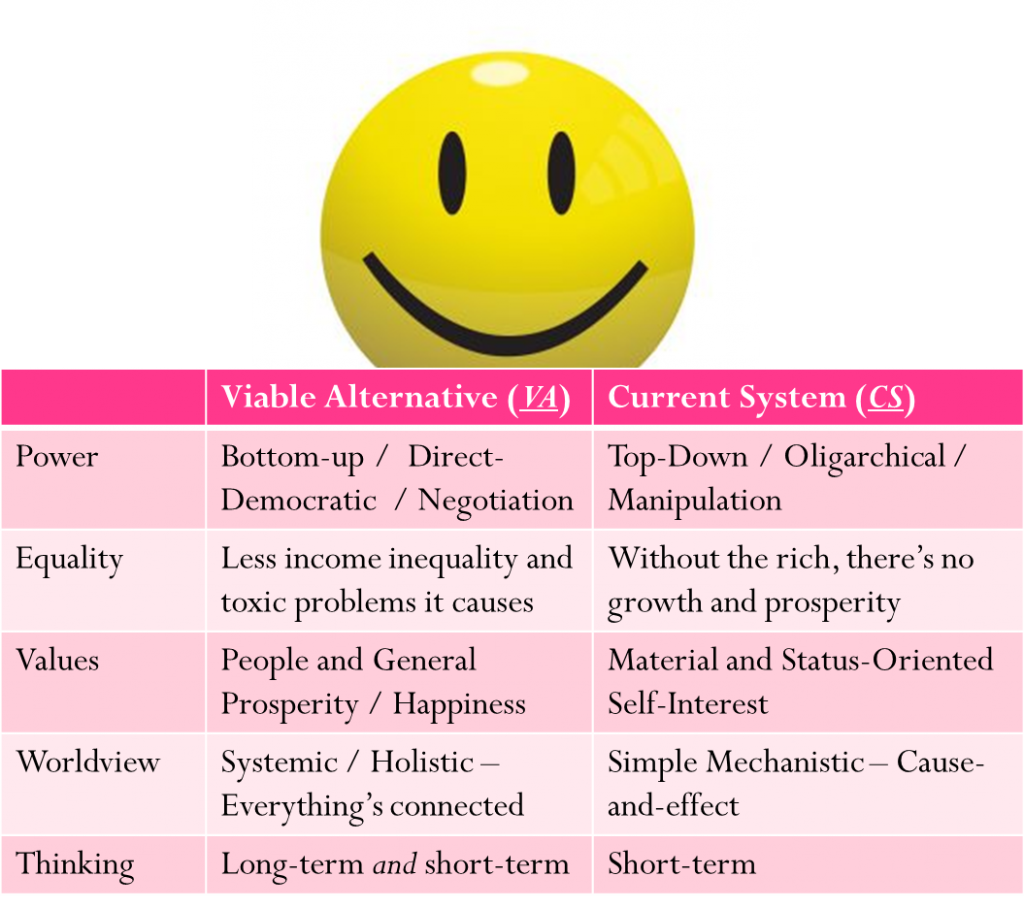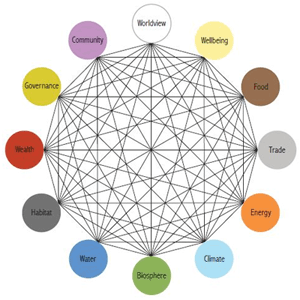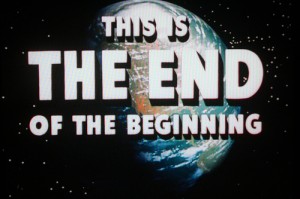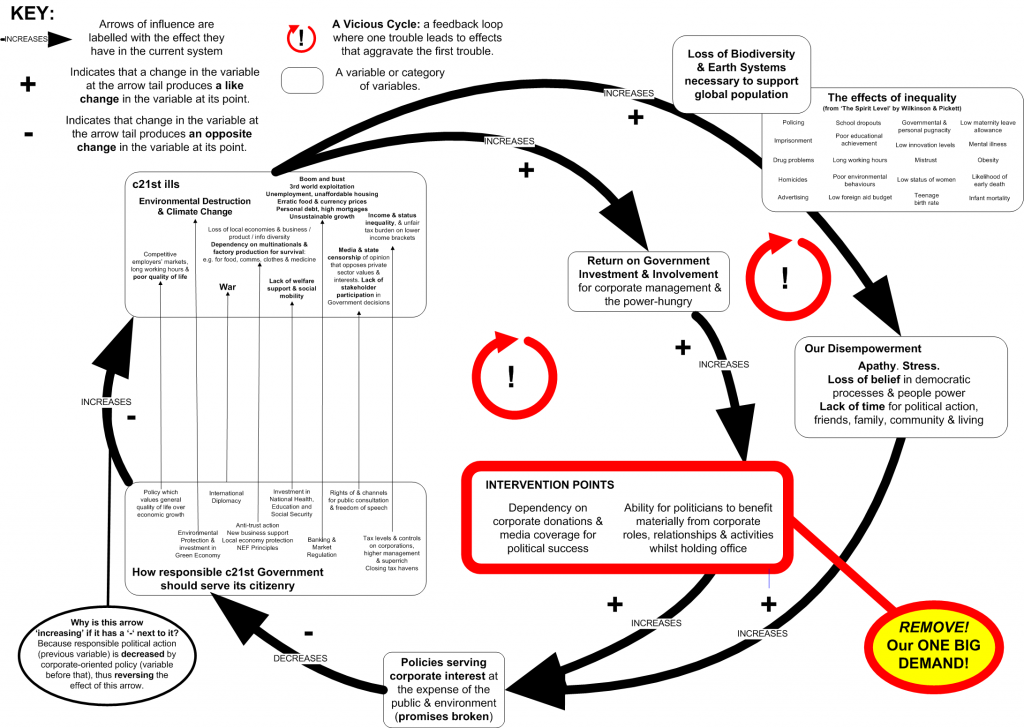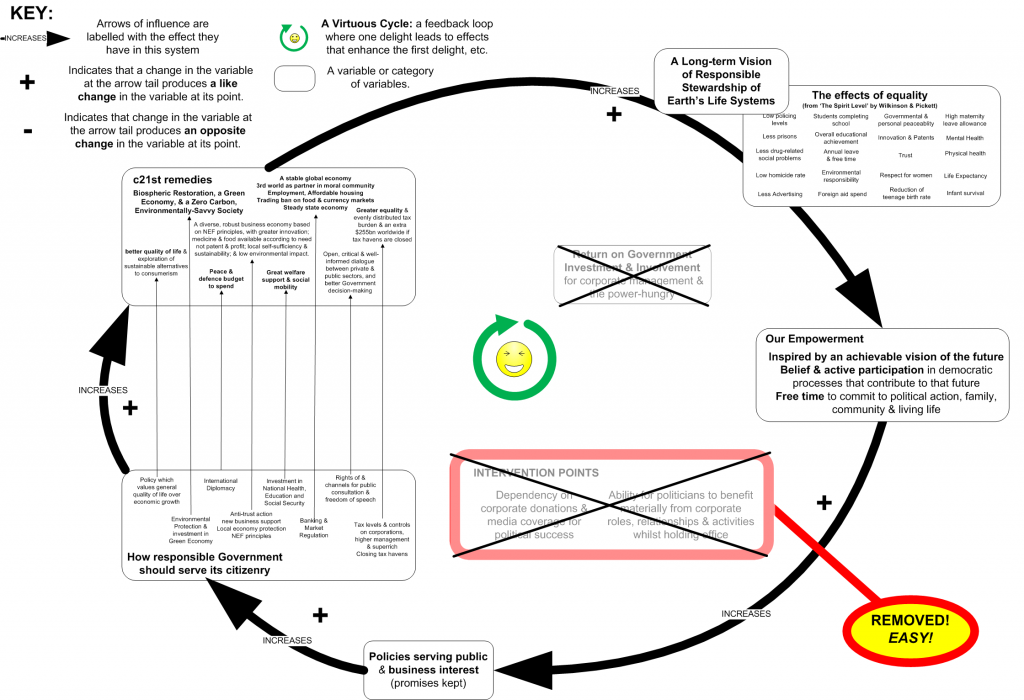What is Occupy? Collective insights from a ‘Whole Systems’ Session with Occupy followers
This article is about a ‘whole systems thinking’ session Arkadian ran with 15 Occupy followers of all ages and backgrounds. All participants were required to answer 3 questions: –
(1) What is Occupy’s purpose; (2) How should this purpose be achieved and; (3) Why was it important?
Personal thoughts were written on post-its, stuck on a wall, and organised by the group according to content similarity and difference. The discussion fueled by these activities gave rise to 6 collective insights (the 7th is an insight Arkadian derived from the others): –
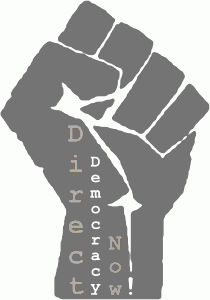 (1) Occupy is a grass-roots, direct-democratic movement
(1) Occupy is a grass-roots, direct-democratic movement
(2) Occupy is ‘about’ co-creating and enacting a Viable Alternative to the current system
(3) The Viable Alternative is a collective vision
(4) Achieving the Viable Alternative requires building critical mass
(5) Building critical mass depends on making the Viable Alternative simple, relevant and clear to the wider population
(6) Aims could be best achieved through grass-roots ‘campaigns’ connecting the Viable Alternative to local community issues
(7) These insights had implications for Occupy’s organisational design
There follows a brief explanation of each: –
1. Occupy is a grass-roots, direct-democratic movement: All followers saw Occupy as ‘of the people / for the people’, independent of, and transcending all, other organisations. There was genuine concern that ‘partnerships’, or Occupy chapters becoming formal or political entities, would compromise the essential qualities of this idea. Nevertheless, it was also acknowledged that high profile support could, and had, delivered some powerful PR.
The solution proposed was that ‘partnerships’ should always be one-way and arms-length only, i.e. limited to inviting, or allowing, third parties to sign up to Occupy’s (viz: ‘the people’s’) aims and principles. But what aims and principles?
2. Occupy is ‘about’ co-creating and enacting a Viable Alternative to the current system: The most powerful theme that emerged in the discussion. To get a handle on some of the structural principles of this Viable Alternative, ask yourself the following questions… 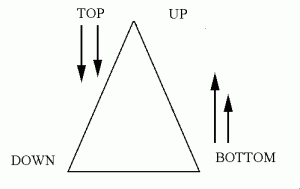
Power: Would the world be better if people had greater involvement in decisions that affect their lives and future?
 Equality: Would the world be better if the gap between rich and poor were reduced? (N.B. Not to a ‘ Communist’ extreme, merely a lessening of the vast multipliers separating high / low incomes and developing / developed nations, and their toxic impact on society and environment).
Equality: Would the world be better if the gap between rich and poor were reduced? (N.B. Not to a ‘ Communist’ extreme, merely a lessening of the vast multipliers separating high / low incomes and developing / developed nations, and their toxic impact on society and environment). 
Values: Would the world be better if quality of life and well being were valued over material and status-driven self-interest?
Worldview: Are the big social, environmental and economic challenges connected in any way? Might addressing one have beneficial effects on others? 
Thinking: Should the well being of future generations and the long-term viability of life on our planet be important to current decision-making?
If you answered ‘Yes’ to any, or all, of these questions then you’re ‘Occupy’. Below is a rough summary table comparing the principles of the Viable Alternative to those of the current system.
So what actions does all this imply? Firstly, if they are widely shared, then these structural principles could provide the ideal framework for coherent organisation, action and communications, and solidarity, across diverse contexts.
Secondly, the Viable Alternative is a positive idea: it’s about a happier, better future. Whilst its necessary to highlight why change is necessary, negative news and arguments about the nitty-gritty can drive people away. Emphasising these higher-level, common and cheerful principles, on the other hand, could score greater successes with the wider population.
3. The Viable Alternative is a collective vision: The whole group shared a belief in the urgent necessity for the Viable Alternative, which in turn, seemed dependent upon an understanding of the scale and interconnectedness of the issues.
However, each individual held their own beliefs about what the important problems were, how they were connected, and the appropriate remedies and actions: a product of their life experiences, personal interests and, for many, exposure to new information since engaging with the movement.
Nevertheless, the post-its-on-the-wall represented a truly epic mess, one that evidently required highly situation-specific solutions, each of which defied the analytic or predictive capabilities of any ‘expert’. Recognition of this within the group seemed to drive processes where individual experiences were tools for building, negotiating and informing a dynamic picture of NOW, in order to decide the best next step(s) only, not the grand master plan.
 Rather than disagreements about which view was ‘right’ or ‘wrong’, all views seemed appreciated as valuable and partially right. In a sense, the group behaved like a ‘super-brain’, leveraging many lifetimes’ worth of perspectives, knowledge and experience to reach wise ‘objective’ assessments and decisions about an impossibly complex ‘subjective’ situation.
Rather than disagreements about which view was ‘right’ or ‘wrong’, all views seemed appreciated as valuable and partially right. In a sense, the group behaved like a ‘super-brain’, leveraging many lifetimes’ worth of perspectives, knowledge and experience to reach wise ‘objective’ assessments and decisions about an impossibly complex ‘subjective’ situation.
So what are the implications of all this? Firstly, if collaborative decision-making can be so individually empowering and collectively clever, then all Occupy followers should be furnished with simple group moderation skills and ‘whole systems’ tools. Processes that focus discussions on external representations (pictures / post-its / models etc.) should become a sine qua non of the movement.
Secondly, the movement should stress that, whilst expressing a personal view is the inalienable right of any follower, unless its braided into a collective decision, it ain’t Occupy!
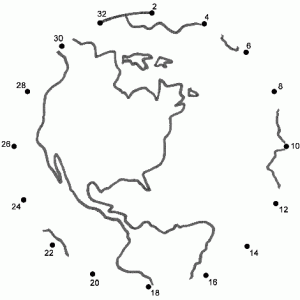 Lastly, if action is motivated by seeing the connections between disparate social, economic and environmental issues, then Occupy should underscore ‘stories’ that highlight the ‘connections’, and fast track new members into contributing to collective decision-making – judging by the discussion, it’s difficult not to ‘join-the-dots’ when exposed to the Occupy ecology.
Lastly, if action is motivated by seeing the connections between disparate social, economic and environmental issues, then Occupy should underscore ‘stories’ that highlight the ‘connections’, and fast track new members into contributing to collective decision-making – judging by the discussion, it’s difficult not to ‘join-the-dots’ when exposed to the Occupy ecology.
(4) Achieving the Viable Alternative requires building critical mass: Reflection upon this fact led rapidly to the recognition that human and financial resources were critical priorities, and that there were probably no shortcuts to them.
(5) Building critical mass depends on making the Viable Alternative simple, relevant and clear to the wider population: The second dominant theme of the session. To successfully engage the wider population, it was deemed Occupy needed communications that were simple, relevant to the differing needs of specific target audiences, and employed clear popularly-understood terminology pitched at the appropriate level of understanding, e.g. stock phrases like ‘socioeconomic justice’ and ‘ecological limits’ were not understood by many in the group. It was also considered important that these messages were backed-up by incontestable evidence and sources, and communicated solidarity.
Everyone also acknowledged this would entail outwitting the ‘guardians’ of the current system ‘at their own game’, exploring channels that they don’t, or can’t easily, command, and responding quickly and devastatingly to opposition. The discussion highlighted that intelligent, reflective information management – researching, screening, organising, tailoring – was central to Occupy’s role and ultimate success.
So, to recap. Occupy needs to…
(i) Organise without being an organisation.
(ii) Communicate a Viable Alternative when no-one can know what it is, and where it is only made manifest via specific situations and perspectives.
(iii) Create an outward appearance of solidarity when structured disagreement is an essential requirement.
(iv) Use channels not covered by the ubiquitous guardians of the current system, whilst building volunteers, funds and critical mass.
What solution to these challenges did the collective propose?
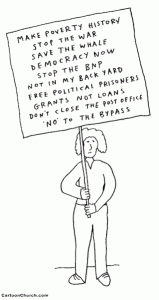 (6) Grass-roots ‘campaigns’ connecting the Viable Alternative to local community issues: Explore and discuss ‘issues’ door-to-door. Those that resonate, have local relevance, and are aligned with the Viable Alternative could then become the focus of grass-roots campaigns, building to direct ‘visible’ action, and all informed by Occupy’s structural principles, particularly, inclusive community decision-making. Not talking and blaming, but showing the world how things could be: through small-scale collaborative achievement and learning.
(6) Grass-roots ‘campaigns’ connecting the Viable Alternative to local community issues: Explore and discuss ‘issues’ door-to-door. Those that resonate, have local relevance, and are aligned with the Viable Alternative could then become the focus of grass-roots campaigns, building to direct ‘visible’ action, and all informed by Occupy’s structural principles, particularly, inclusive community decision-making. Not talking and blaming, but showing the world how things could be: through small-scale collaborative achievement and learning.
(7) These previous 6 insights had implications for Occupy’s organisational design: The final insight, Arkadian’s own, was that attaining all of the previous objectives implied a radically new organisational design, lest rapid growth give rise to hierarchy – the spoiling of many a revolution and NGO, and, in Occupy’s case: a fundamental hypocrisy.
A model where multiple ‘cross-pollinating’ cells are structured around local campaigns / action and mutually agreed principles of the Viable Alternative, perhaps? For a future session…
So, to conclude, at Occupy’s heart is a Viable Alternative that really is the current system turned on its head. A total paradigm shift, but a necessary one, if we are to share a remotely tolerable future.
Moreover, maybe change is easier than it seems. After all , the principles of the Viable Alternative are neither unfamiliar nor new, are they? Arguably, they, and not those of the current system, have determined how we cooperate with our nearest and dearest since time immemorial. We just need to realise the whole world could and should work this way.
Why Corporate Regulation is a Socioenvironmental Necessity. Part 3 of 5: Why does A Diverse System = A Stable System?
Delighted that you’ve joined us for the third installment of our first Arkadian analysis for 2012, where over five short articles, we will show how we reached the series title’s conclusion by way of the following question: –
“What difference between natural / social systems and the current economic system causes the former to tend towards diversity and stability, and the latter, uniformity and instability?”
In Weeks 1 and 2, we investigated why ecosystems and ‘civilisation’ tend towards diversity and stability. It was proposed this was attributable to virtuous dynamics that promote long-term systemic stability and resilience by driving increasingly fine-grained specialisation / cooperation, whilst inhibiting environmental dominance by particular species or social ‘groups’.
Next week we will be putting forward an explanation as to why the current economic system displays the reverse trend but, for now, we thought it worthwhile to explain briefly the connection between diversity and stability. Why exactly does a change in the former result in a like change in the latter?
Put simply, in a diverse system, the health of the whole (‘productivity’) isn’t dependent on the performance of only a few parts.
 For example, imagine a disadvantaged family where Dad is the only breadwinner. If he has an accident, no-one eats. If the house blows down in a storm, there’s no-one to rebuild it. Compare the situation with a second family where several other members also contribute to the household income. Because ‘productivity’ is distributed across several people, the overall family ‘system’ is much more able to adapt to an accident-prone Dad and / or a force majeure.
For example, imagine a disadvantaged family where Dad is the only breadwinner. If he has an accident, no-one eats. If the house blows down in a storm, there’s no-one to rebuild it. Compare the situation with a second family where several other members also contribute to the household income. Because ‘productivity’ is distributed across several people, the overall family ‘system’ is much more able to adapt to an accident-prone Dad and / or a force majeure.
 A classic instance of systemic over-dependency at a macro-societal level is Ancient Egypt, which teetered on a single variable: the annual flooding of the Nile (taken from the excellent ‘Water’ by Steven Solomon). The ‘inundation‘, as it was known, rejuvenated the plains with fertile silt and washed away soil poisons, to produce the most self-sustaining and fertile farmlands of the ancient world.
A classic instance of systemic over-dependency at a macro-societal level is Ancient Egypt, which teetered on a single variable: the annual flooding of the Nile (taken from the excellent ‘Water’ by Steven Solomon). The ‘inundation‘, as it was known, rejuvenated the plains with fertile silt and washed away soil poisons, to produce the most self-sustaining and fertile farmlands of the ancient world.
The exclusive focus of the political elite was water management: senior priest-managers led departments for overseeing dikes, canal workers and measuring river levels; and top dog, Pharaoh’s, fundamental godly responsibility was mastery of the flow of the great river.
Unsurprisingly then, the Nile and Egyptian history ebb and flow in perfect synchronicity. Without exception, the Old, Middle, and New Kingdoms, as well as the later periods of Greek and Byzantine rule, bloom with the return of the regular cycle of flooding and crumple with climactic dry periods into centuries of disunity, chaos and foreign invasions. Thus, despite many environmental blessings, ultimately, the stability and resilience of this mighty civilisation and its elite were slave to the caprices of its one water source, in a way that a country with abundant springs, rivers and lakes could never be.
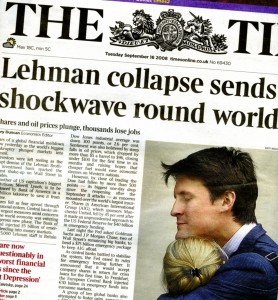 Our third and final example – the current economic downturn – illustrates uniformity and instability at a global level. Here, the world’s banking system was rendered so fragile by the interdependency of a few titanic banks and financial services firms, that massive external intervention was required to prevent total meltdown when one of them, Lehman Brothers, filed for bankruptcy in 2009. It is a crisis and an intervention for which we shall all suffer for many decades to come.
Our third and final example – the current economic downturn – illustrates uniformity and instability at a global level. Here, the world’s banking system was rendered so fragile by the interdependency of a few titanic banks and financial services firms, that massive external intervention was required to prevent total meltdown when one of them, Lehman Brothers, filed for bankruptcy in 2009. It is a crisis and an intervention for which we shall all suffer for many decades to come.
But why had the economic system not behaved like the natural / social systems we looked at in Weeks 1 and 2, and become increasingly diverse and stable as it expanded? We hope you’ll drop in next Friday to find out.
Why Corporate Regulation is a Socioenvironmental Necessity. Part 1 of 5: Why do Ecosystems tend towards Diversity and Stability?
 Happy New Year and welcome to our first Arkadian analysis of 2012. Over the next five weeks we will be working towards the conclusion of the title of the series by exploring the answer to a simple question: –
Happy New Year and welcome to our first Arkadian analysis of 2012. Over the next five weeks we will be working towards the conclusion of the title of the series by exploring the answer to a simple question: –
“What difference between natural / social systems and the current economic system causes the former to tend towards diversity and stability, and the latter, uniformity and instability?”
In a world where the latter now poses a mortal threat to the former, we considered this to be a question of some significance. Could we learn from the way natural / social systems self-regulate in a way that benefits all, to design an ecologically-and-socially-just economic system?
Our analysis will be set out in five short articles, launching Friday mornings throughout January and early February: –
(1) Why do Ecosystems tend towards Diversity and Stability? Friday 6th January 2012.
(2) Why does (did) Civilisation tend towards Diversity and Stability? Friday 13th January 2012.
(3) Why do Diverse Systems = Stable Systems? Friday 20th January 2012.
(4) Why does the Current Economic System tend towards Uniformity and Instability? Friday 27th January 2012.
(5) How do we create a Diverse and Stable Economic System? Friday 28th September 2012.
So without further ado, let’s move onto our first question of the series:
Why do Ecosystems tend towards Diversity and Stability?
As a general rule the longer that ecosystems remain undisturbed by external factors, the richer they become. The oldest – the rainforests – are estimated to hold over half of all species, despite covering only 6% of the Earth’s surface. Why should 70m years of evolution against a backdrop of dynamic climate fluctuations give rise to increasing variety and not just a few dominant species?
MODEL 1 of our analysis below proposes an answer (N.B. If you have trouble reading the text, click on the diagram to open it in a new browser tab and then refer back to the explanation here).
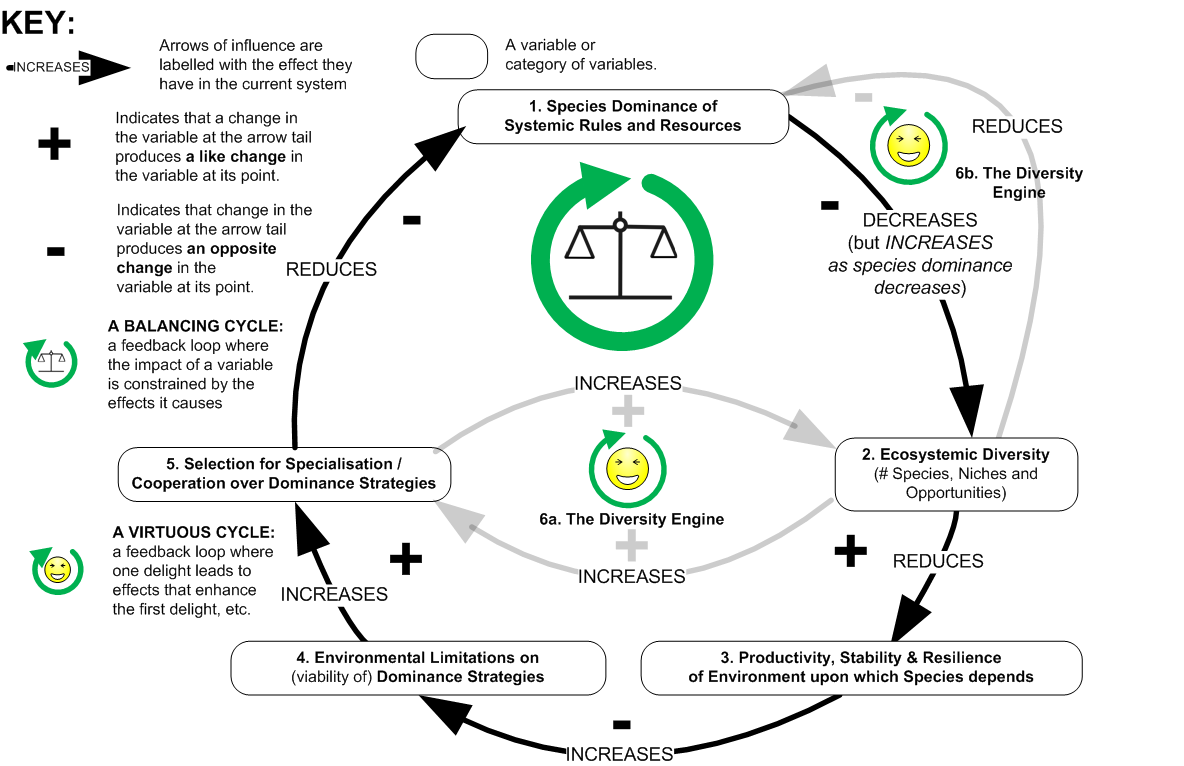 Begin at the topmost variable and follow the arrows clockwise around the loop. (1) Put yourself in the position of a species that pursues total dominance over its local environment. (2) Despite considerable early successes, it’s not long before your manipulation and consumption begin to impact adversely on other species. (3) As local biodiversity diminishes, so too do the health, resilience and stability of the ecosystem as a whole, (4) resulting in ever-tighter constraints on your actions and, ultimately, the collapse of the environment upon which your own survival depends. (5) Your extinction kills off that suicidal gene that motivated your thirst for dominance, leaving an open stage for adaptive strategies that promote ecosystemic diversity and stability.
Begin at the topmost variable and follow the arrows clockwise around the loop. (1) Put yourself in the position of a species that pursues total dominance over its local environment. (2) Despite considerable early successes, it’s not long before your manipulation and consumption begin to impact adversely on other species. (3) As local biodiversity diminishes, so too do the health, resilience and stability of the ecosystem as a whole, (4) resulting in ever-tighter constraints on your actions and, ultimately, the collapse of the environment upon which your own survival depends. (5) Your extinction kills off that suicidal gene that motivated your thirst for dominance, leaving an open stage for adaptive strategies that promote ecosystemic diversity and stability.
Thus, coming full circle, (1) Your Environmental Dominance Strategy proved self-defeating because it led to Ecosystemic Weaknesses that constrained and, ultimately, negated, You! In Systems Dynamics a feedback loop like this where the impact of a variable is reduced by the effects it causes is called a ‘Balancing Circle’.
 A further notable dynamic here is a pair of ‘Virtuous Circles’ (feedback loops where one delight leads to effects that enhance the first delight, and so on), which we’ve termed the ‘The Diversity Engine’.
A further notable dynamic here is a pair of ‘Virtuous Circles’ (feedback loops where one delight leads to effects that enhance the first delight, and so on), which we’ve termed the ‘The Diversity Engine’.
Here, (6a) the more the processes of natural selection incline towards interdependence, the more opportunities are opened up for new evolutionary adaptations. Thus, through increasingly fine-grained cooperation and specialisation between species, diversity itself drives diversity.
Moreover, as the environment grows ever more rich and complex, (6b) species dominance becomes increasingly futile and improbable, removing a further constraint on the trend towards diversity. And so both circles turn.
But (we hear you say) isn’t there a species that has had a radical effect on its local environment but has (thus far) escaped extinction? We hope you’ll drop in next Friday for Part 2, when we shall be exploring the curious exception of Homo Sapiens.
What the One Demand of the ‘Occupy’ Movement should be and why.
Today was Occupy Wall Street’s first Global Day of Action. We’re on our way home from our local urban occupation, feeling inspired, hopeful and slightly unsettled. Inspired and hopeful because people of all ages and backgrounds from around the world joined in protest against a corrupt economic system; unsettled due to a heated difference of opinion about what to do and who to battle (thankfully, and topically, resolved democratically and peaceably).
History is strewn with social movements that imploded through infighting, or where, for lack of a clear aim, the chaotic forces of moral indignation were steered by groups, with a plan and organisation, towards their own agenda (and, usually, more of the same). For either to happen to this beautiful movement would be a tragedy of inestimable proportions.
So is there a single aim that could unite the 99%?
The answer to this, we believe, lies in a further question: how is it that in a democratic system the 99% can be so flagrantly disregarded? This points to a problem with the machinery of Democracy itself. Perhaps, if we could locate the faulty part and fix or replace it, these diverse opinions would be enriching collective solutions rather than jeopardising their own vehicle for liberation?
There follows a 2-part systems dynamics analysis to this end.
PART 1 proposes two Vicious Circles at work in the current system. These are series of events where one trouble leads to troubles that further aggravate that first trouble, and so on
(N.B. It’s easiest to click on the diagram to open it in a new browser and then refer back to the explanation here. Depending on your screen size, you may also need to zoom in-and-out in order to read the smaller text by clicking on the relevant area).
The best place to start is at the bottom where government policies that serve corporate interests are pursued at the expense of those that serve the 99% and the natural environment.
Whilst this enriches the 1% and motivates them to even greater future investments in manipulating Government policy (the 1st Vicious Circle – inner), it also exacerbates a range of hugely-profitable (in the short-term) c21st century ills: war, recession, inequality, loss of public services and assets, our increasing dependency on corporations for life’s essentials and, most critically, a severe threat to Earth’s life systems.
These factors, together with diminishing quality-of-life and broken political promises intensify our apathy and denial, and reduce time or inclination for political action, thus eroding a key constraining factor on the corporate policy abuses with which we began (the 1st Vicious Circle – outer). And so the Circles turn.
The analysis suggested two potential intervention points (highlighted in red) where action could positively transform the Vicious Circles. These are: –
(1) Dependency on corporate relationships for political success. In short, a business wouldn’t bestow cash or media coverage on a political campaign that didn’t promise a significant return on investment. A third of the world’s 100 largest economic entities are now transnational corporations. Without bowing to these giants, no party has a hope of achieving or maintaining office, irrespective of good intentions and promises. Why pursue a policy or preserve a public service, asset, safeguard or freedom when losing it stands to make somebody a tidy profit?
(2) Ability for politicians to benefit materially from political office as a result of corporate relationships. Whilst we do not share many of Plato’s views (on Democracy, for example), we do agree that the worst form of government is one where the actions that satisfy the desires of the ruler become law. A tyranny. It was with good reason that The Republic went to great pains to isolate its philosopher kings from the temptation of riches and military stardom, the great corruptors of wise governance.
Under the Republic, for example, a former Prime Minister who made $40bn out of a dubious war he instigated whilst in office or a secret council assembled to draft laws to serve its own self-interest would have faced certain execution.
 To put it simply, if we wish our countries to be run by people motivated by a desire to serve its citizenry and not by material self-interest then, within the political sphere, constraints on the latter must be codified in law and regulated independently. After all, corporate management takes conflict-of-interest very seriously. They know, as Plato did, that a person cannot responsibly wear two hats when money is involved.
To put it simply, if we wish our countries to be run by people motivated by a desire to serve its citizenry and not by material self-interest then, within the political sphere, constraints on the latter must be codified in law and regulated independently. After all, corporate management takes conflict-of-interest very seriously. They know, as Plato did, that a person cannot responsibly wear two hats when money is involved.
For PART 2 of the analysis the ‘Occupy’ Movement collectively waves its magic wand and divorces the public and private sectors, turning our Vicious Circles into its cheerful alter ego, a Virtuous Circle, where a delight leads to delights that further promote the first delight, and so on
(N.B. Again, it’s easiest to click on the diagram to open it in a new browser and then refer back to the explanation here. Depending on your screen size, you may also need to zoom in-and-out in order to read the smaller text by clicking on the relevant area)
Here, diverse opinion (with better access to information about actual environmental and economic constraints) is braided via participatory democratic processes and well-behaved politicians into policies that best serve both public and private interest.
This leads to a host of positive socioenvironmental effects that increase faith in people-power, government and the future. It also confers the time to get involved, thus contributing to even greater participation and ever richer solutions. And so the Virtuous Circle turns: driven by a commitment to a better world in the long-term.
Call us idealistic, but we believe this vision of an equitable sustainable society where stakeholders are actively engaged in Government is wholly imaginable, achievable and necessary. Moreover, It will not require earth-shattering change and would improve general quality-of-life.
However, we acknowledge that, as evidence of the Arkadian worldview – steady state economics, new economics principles, Just Transition , equality, environmental restoration, nurturing new values etc. – seeps in here, it would be best to declare the pertinent aspects. We ask that anybody who posts comments extends us the same courtesy as it makes discussion of opinions easier and so much more fruitful.
“Arkadian Systems Worldview: That the current economic system has been proven environmentally unsustainable and thus we must explore and enact alternatives or risk socioenvironmental collapse and extinction. That social and environmental justice are so intimately intertwined that treatment of one leads inevitably to reinforcing effects on the other. That decision-making is always wiser when all stakeholders with an interest in the relevant situation are meaningfully involved. ”
We should also stress that it is only the last of these – the principle underpinning a true Participatory Democracy – that should be considered relevant here. If Democracy is reformed and re-fired, we’re confident the rest will happen all by itself, the right way, and our opinion will be one of millions that make a contribution. So, to conclude,
The One Demand of the ‘Occupy’ Movement should be:
“GET BUSINESS OUT OF POLITICS AND LET THE PEOPLE IN”:
Insert a robust legal and regulatory framework between the private and public sectors, which enables Government to draft policy and law without conflict-of-interest and according to the principles of Participatory Democracy
Specifically, this framework should render it impossible for politicians to benefit materially from political office as a result of corporate relationships and should define equitable and corporate-independent alternatives to campaign funding .
For us, this is eminently preferable to smashing the bankers, police, politicians, Capitalism, Consumerism: THE SYSTEM. Trying to fight The System or one of its organs, inevitably results in giving oneself a bloody nose and the awful realisation that, yes, it also includes ME!
Recent Posts
- Seeding a Viable Economic Alternative. Pt 3: Placing Mother Nature First
- Seeding a Viable Economic Alternative. Pt 4: Ego-as-Process
- Charlie Hebdo and the Immorality Loop
- My Top 20 Waterfalls Pt3 (S America: #2-1)
- My Top 20 Waterfalls Pt2 (S America: #7-3)
- My Top 20 Waterfalls Pt1 (Africa, Asia, Europe & N America)
- Positive Change using Biological Principles, Pt 4: Principles in Action
- Positive Change using Biological Principles Pt 3: Freedom from the Community Principle
- Positive Change using Biological Principles Pt 2: The missing Community Principle
- Positive Change using Biological Principles, Pt 1: The Campaign Complex
- Seeding a Viable Economic Alternative. Pt 2: The Principal Themes (Outcomes of a Systems Workshop at Future Connections 2012)
- Seeding a Viable Economic Alternative. Pt 1: The Action Plan (Outcomes of a Systems Workshop at Future Connections 2012)
- What I Learned from Destroying the Universe
- Why Corporate Regulation is a Socioenvironmental Necessity. Part 5 of 5: How do We Create a Diverse and Stable Economic System?
- The Root of all Evil: how the UK Banking System is ruining everything and how easily we can fix it.
- What is Occupy? Collective insights from a ‘Whole Systems’ Session with Occupy followers
- Why Corporate Regulation is a Socioenvironmental Necessity. Part 4 of 5: Why does the current Economic System tend towards Uniformity and Instability?
- Why Corporate Regulation is a Socioenvironmental Necessity. Part 3 of 5: Why does A Diverse System = A Stable System?
- Why Corporate Regulation is a Socioenvironmental Necessity. Part 2 of 5: Why does (did) Civilisation tend towards Diversity and Stability?
- Why Corporate Regulation is a Socioenvironmental Necessity. Part 1 of 5: Why do Ecosystems tend towards Diversity and Stability?







